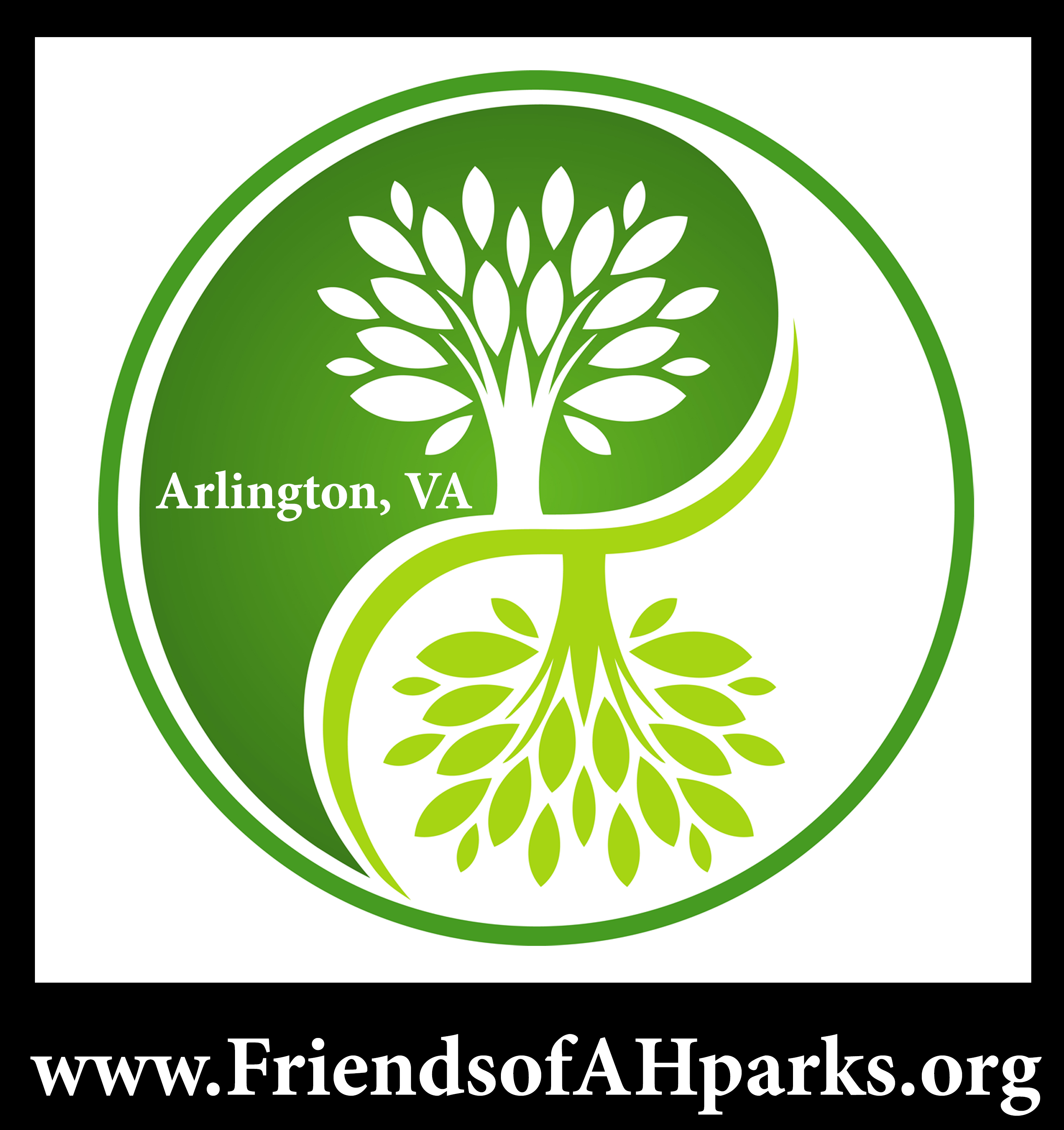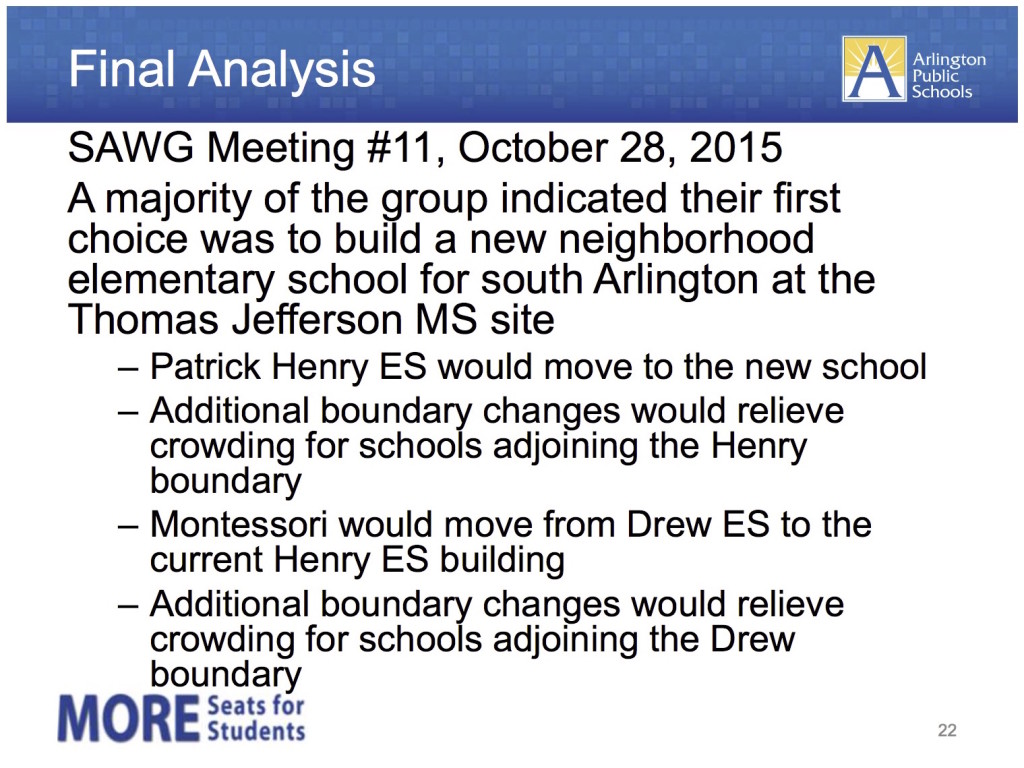A 9 Page Summary of the South Arlington Working Group Final Report
& Potential Impacts.
http://bit.ly/1SrVQdA
South Arlington’s Working Group’s Final Analysis.
Below is from the October 29th SAWG presentation at the Community Forum.
To see more information about school siting in Virginia Highlands Park/Community Center/River House, please click here.
APS South Arlington Group
Meetings #7 & #8 – Sept. 9 & 16, 2015
Prepared by Sarah McKinley
Columbia Heights Civic Association
The 7th and 8th meetings of the “APS South Arlington Community Working Group” focused on ongoing discussions about properties and attempts to winnow the list of possibilities. The meetings also focused on performance of the schools and program issues. The meetings were led by the Working Group Chairman Greg Greeley.
Presentation on Academic Performance
The September 9 meeting in the Wakefield High School cafeteria focused on a presentation by Connie Skelton on academic performance in South Arlington schools. The data for each school included separate data for those students in each school who were economically disadvantaged (those with free or reduced lunches), those that are bilingual, and special needs students.
There are gaps in scores in general between schools in North Arlington vs. South Arlington. But then, the southern schools have more economically disadvantaged students, and more non-English speaking children who are in the ESOL/HILT/HILTEX program. Ms. Skelton explained that it took 5-6 years for the ESOL kids to catch up, because the tests are in English. By the time they graduate from that program, however, their scores are almost identical to the rest of the school population. So she urged the group not to interpret the differences in scores without taking that into account. Scores in South Arlington are comparable to the state as a whole.
One school that was troubling for the group was Drew. When test scores for the Montessori program are taken out, the test scores for the neighborhood school program (about 200 students) were much lower than for the other South Arlington neighborhoods.
One experiment this year was a program that allowed students to retake the tests if they were close to passing, or if there were special circumstances. Teachers were willing to give those kids extra attention, and there was a lot of parent support. The result is that a lot of those children were able to raise their scores with minimal added help. The good news is that Arlington this year won’t have any schools that fall within the bottom 15% of the state, a condition that imposes state sanctions on schools.
Scenarios for School Possibilities
Between the September 9 and the September 16 meeting a number of participants put forward various scenarios. The September 16 meeting was held at TJ Middle School. An opening presentation included a recap of the sites now under consideration. There continued to be discussion of including Barcroft Park and Jennie Dean in the larger mix.
Montessori Program. Resolution of the placement of the Montessori program played a major role in a lot of scenarios. One suggestion was to leave Montessori at Drew, making that a stand-alone program, building a second grade school on the Drew campus and moving the current Drew neighborhood students into the new school. Other suggestions: Move Montessori to the old hospital on Carlin Springs Road, either through a negotiated lease, lease with option to sell, or simply part of the (future) land swap with the County now under consideration. Another suggestion: Move Montessori to Hoffman-Boston, and incorporate all of the current children at that school into Drew, with a second school at Drew (perhaps and upper and lower elementary on that campus). Another suggestion was to move Montessori to Claremont. Another possibility: building the new school at TJ, moving Patrick Henry into the new school and shifting Montessori to become a stand-alone program at Patrick Henry. Finally: building a second school at Gunston and moving Montessori into that location.
Drew Campus. Some participants familiar with Drew felt that the neighborhood school suffered because of the incompatibility of being coupled with the Montessori program, and felt that those children would do better if that reverted back to a standard neighborhood school with the attention it deserved. The Nauck community very much wants Drew to remain a neighborhood school. Their community has a history of their students being bused all over Arlington to achieve racial diversity. They want a school their children can walk to. They also want the Montessori program to move out of the neighborhood. One option would be to build a second grade school at Drew, creating and upper/lower elementary, which would create enough space for a lot of Nauck students now attending Hoffman-Boston to move back, with redistricting from Patrick Henry, Abingdon, and Barcroft. Because Drew is centrally-located to all those schools, this would result in less disruption.
Jennie Dean. Some participants still wanted Jennie Dean Park to remain under consideration, although it was clear that APS didn’t support it because of its location in a flood zone. Shirlington produced a document outlining the issues over floods and the lack of insurance available for the few buildings that did exist on the site. Clearly, these structures would be built today. The majority of participants appeared willing to drop Jennie Dean from the list.
Barcroft Park. Although APS did not provide architectural drawings, they reported that Barcroft Park would not be suitable. It would require a 5-story building with not enough access to the street for the lower grades. In addition, it did not appear that stories could be added to the parking garage. There was not much discussion in the group about using Barcroft Park.
Claremont. Claremont has now been described as a “neighborhood immersion” school. Those who live in the neighborhood and in Abingdon have an automatic right to send their kids there. Visitors at both meetings urged the group to keep Claremont an immersion school. Some argued that they purchased their homes specifically to send their kids to this school. Other parents argued that it was unfair to completely disallow students outside of the neighborhood. Abington students have priority enrollment in Claremont. There was discussion about the value of creating another immersion program to increase these opportunities, both for North and South Arlington kids. However, the charge of the group is to site a neighborhood school, so any consideration of another immersion school would have to be considered separately, at some future time. The Abingdon school district has the greatest number of students attending other schools.
Wakefield. There was widespread opposition to building a new school on the Wakefield campus. Neighbors who lived through the Wakefield construction complained that they couldn’t go through it again. Others worried that Wakefield needed the playing field for its own activities, and that building there would preclude any future expansions of Wakefield.
Thomas Jefferson. There was also considerable opposition to building a new school at TJ, despite a very good design that was created through the TJ working process last year. One argument was that,to benefit the greatest number of South Arlington students, the new school needed to be built farther south in our territory, which would preclude both TJ and the Virginia Hospital site on Carlin Springs Road. In addition, there were arguments that building now on the west parking lot at TJ would preclude future expansions of the TJ middle school.
Gunston. One option raised by the Montessori parents was the possibility of building the next school at the Gunston campus, and moving the Montessori program there. However, the Oakridge group argued that Gunston was at the very tip of their territory, arguing that the Virginia Highlands Park or Vornado sites would be preferable.
Virginia Highlands/Vornado. Participants did not really discuss the Oakridge territory. It appeared that there was consensus that Virginia Highlands was a highly desirable site, but one that would require a lengthy process to integrate a school there as a co-located facility with the Community Center, Public Library, senior programs and the existing fire station. Vornado, located nearby, would also require a lengthy public process, both with the neighborhoods and with Arlington County. It was suggested that a public process to sort this out should begin soon, in order to allow the County to build a new school in the Oakridge territory within the not-too-distant future. Oakridge members stated that they would support the first school being built on the west side. But they also don’t want to be forgotten in the process.
At the end of the meeting participants identified sites for a first and second school site, which will be evaluated for the next meeting.
Materials:
Presentation for Meeting #7:
http://www.apsva.us/cms/lib2/VA01000586/Centricity/Domain/110/08122015%20SARL%20Meeting%207.pdf
Meeting # 7 Minutes:
Presentation for Meeting #8:
Meeting #8 – Possible Configurations:

